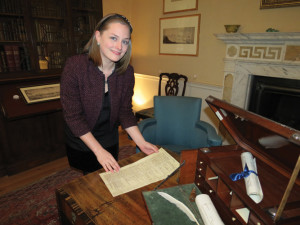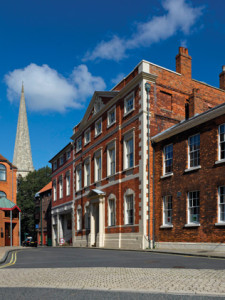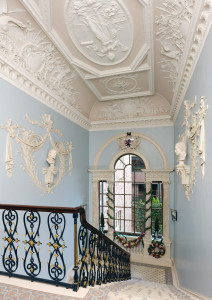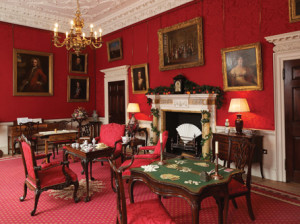Trust Intern at Fairfax House, York
EMERGING SCHOLARS > CURATORIAL INTERNSHIP GRANTS
Report by Louisa Brouwer
In early September 2011, I arrived in York, England to embark on what has proven to be a journey of new experiences. Walking through the cobbled streets of historic York on that first day, I arrived at the offices of Fairfax House—now an historic Georgian townhouse museum open to the public—quite unsure of what to expect. What I found was a jewel of a building, a magnificent eighteenth-century family home designed by John Carr of York and situated on Castlegate Street within the walls of the ancient city, its ceilings dripping with elaborate plasterwork friezes and its interiors populated with one of England’s best collections of Georgian furniture, clocks and artwork.
Although not my first time living in the United Kingdom, this year is the culmination of five years’ fascination with English culture and history. From 2006–2007, I studied history of art at the University of Warwick, before attending the Winterthur M.A. Program in American Material Culture, where my master’s thesis investigated an English jewelry retailer named Susanna Passavant, whose luxury merchandise travelled from London to Mount Vernon. This summer, I had the good fortune to participate in the 60th annual Attingham Summer School as a Royal Oak Foundation Scholar, learning much about the structure of cultural heritage in the United Kingdom.
However, it is this year which has been especially enlightening for me on both a personal and professional level. Since September, I have had the honor to serve as Curatorial Intern at Fairfax House, one of England’s most important eighteenth-century townhouses and now a leading center for the study of Georgian life and design. I work in direct collaboration with the museum’s Director, Hannah Phillip, and am involved in a wide range of projects spanning the breadth of the museum field. Although only eight months through my year, I have already gained valuable work experience in the areas of collections management, conservation, grant writing, exhibitions and archival research. Additionally, I have participated in numerous professional development opportunities, including conferences, site visits and networking events.
My first task was to learn about the museum’s extensive collections, largely donated to the house by the York chocolate magnate Noel Terry in 1980. Terry’s collection of Georgian furniture and decorative arts is widely recognized as one of the finest ever amassed in England, described by Sotheby’s as comprising some of the best examples of British cabinetmaking and horology from the eighteenth century. In my first two months in the Curatorial Department,
I kept busy with cataloguing, photographing and applying accession numbers to objects in the Library, Dining Room and Kitchen. The pleasure derived from examining an original library bookcase produced in Thomas Chippendale’s London shop, or adding a delicate accession number to a serpentine chest of drawers carrying the maker’s name of John Linnell, is one that only a true material culture scholar can appreciate.
Next, I began work on an upcoming exhibition concerning the Jacobite rebellions of England and Scotland. The exhibition is inspired by the wonderfully symbolic iron staircase balustrade in the Great Hall of Fairfax House, a masterpiece created by the Leeds ironworker Maurice Tobin in the 1760s. The balustrade features delicate wrought rosebuds, which may be an allusion to the House of Stuart and the succession of the “Young Pretender,” Bonnie Prince Charlie.
The Fairfaxes were devout Catholics (as were the Stuarts) in an era of great religious suspicion and fear, providing another important aspect for the exhibition to explore. So far, I have completed extensive object research in the quest for appropriate Jacobite-related material, including everything from basket-hilted broadswords to secret anamorphic portraits. I am currently finalizing an objects list, preparing loan requests, and creating a preliminary layout of the gallery space. This project has been a valuable, hands-on introduction to the many intricacies of exhibition development and design.
My most extensive project to date, however, involves the research and writing of a new furnishing plan for Fairfax House, based on the Fairfax family archives at the North Yorkshire County Record Office. Using this extensive collection of family papers as primary source material, I am compiling over 2,000 documents—including letters, bills, and furnishing vouchers—in an effort to reappraise the interiors of Fairfax House and suggest ways to present the home as it would have appeared in the Georgian period. This plan will include highly specific furnishing details drawn from the family archives, and aims to investigate such pertinent topics as room use, furniture and textiles display, and the layout of the lost service quarters.
As such, the furnishing plan will have exciting ramifications for the future development of the interiors and interpretation of this important townhouse and museum.
In addition to the many day-to-day and long-term projects I am involved with this year, I’m also finding time to have a little fun at Fairfax House. Around Thanksgiving last year, the constant barrage of inquisitive questions surrounding this most mysterious of American holidays prompted the Director to institute a new tradition of staff dinners for “special occasions,” both British and American. So far, we have dined on turkey and pumpkin pie for Thanksgiving and savored local roast beef and Yorkshire puddings for St. George’s Day. Next up will be the Fourth of July, where I’ll introduce my British colleagues to the special pairing of hamburgers and hand-held sparklers on this most patriotic of American holidays.
I am deeply thankful to the Decorative Arts Trust, whose generous internship has made this year a reality for me. The position of Curatorial Intern represents an essential stepping-stone in my career development in the museum field, providing me with a rich diversity of experience that can only be achieved in the focused but ambitious work environment of the small house museum. The first eight months of this year have been both engaging and challenging, and I fully expect the remaining four to be just as equally rewarding.
The museum has a very good website, which provides a lot of information on the house and its collections: www.fairfaxhouse.co.uk/
— LB
SAVE THE DATE
- Spring Symposium New Orleans April, 2018
- Spring Study Trip Abroad Sweden & Denmark Late May-Early June 2018
- Fall Symposium Upper Hudson River Valley September 2018
- Fall Study Trip Abroad Vienna, Prague & Budapest October, 2018
Report by Louisa Brouwer
In early September 2011, I arrived in York, England to embark on what has proven to be a journey of new experiences. Walking through the cobbled streets of historic York on that first day, I arrived at the offices of Fairfax House—now an historic Georgian townhouse museum open to the public—quite unsure of what to expect. What I found was a jewel of a building, a magnificent eighteenth-century family home designed by John Carr of York and situated on Castlegate Street within the walls of the ancient city, its ceilings dripping with elaborate plasterwork friezes and its interiors populated with one of England’s best collections of Georgian furniture, clocks and artwork.
Although not my first time living in the United Kingdom, this year is the culmination of five years’ fascination with English culture and history. From 2006–2007, I studied history of art at the University of Warwick, before attending the Winterthur M.A. Program in American Material Culture, where my master’s thesis investigated an English jewelry retailer named Susanna Passavant, whose luxury merchandise travelled from London to Mount Vernon. This summer, I had the good fortune to participate in the 60th annual Attingham Summer School as a Royal Oak Foundation Scholar, learning much about the structure of cultural heritage in the United Kingdom.
However, it is this year which has been especially enlightening for me on both a personal and professional level. Since September, I have had the honor to serve as Curatorial Intern at Fairfax House, one of England’s most important eighteenth-century townhouses and now a leading center for the study of Georgian life and design. I work in direct collaboration with the museum’s Director, Hannah Phillip, and am involved in a wide range of projects spanning the breadth of the museum field. Although only eight months through my year, I have already gained valuable work experience in the areas of collections management, conservation, grant writing, exhibitions and archival research. Additionally, I have participated in numerous professional development opportunities, including conferences, site visits and networking events.
My first task was to learn about the museum’s extensive collections, largely donated to the house by the York chocolate magnate Noel Terry in 1980. Terry’s collection of Georgian furniture and decorative arts is widely recognized as one of the finest ever amassed in England, described by Sotheby’s as comprising some of the best examples of British cabinetmaking and horology from the eighteenth century. In my first two months in the Curatorial Department,
I kept busy with cataloguing, photographing and applying accession numbers to objects in the Library, Dining Room and Kitchen. The pleasure derived from examining an original library bookcase produced in Thomas Chippendale’s London shop, or adding a delicate accession number to a serpentine chest of drawers carrying the maker’s name of John Linnell, is one that only a true material culture scholar can appreciate.
Next, I began work on an upcoming exhibition concerning the Jacobite rebellions of England and Scotland. The exhibition is inspired by the wonderfully symbolic iron staircase balustrade in the Great Hall of Fairfax House, a masterpiece created by the Leeds ironworker Maurice Tobin in the 1760s. The balustrade features delicate wrought rosebuds, which may be an allusion to the House of Stuart and the succession of the “Young Pretender,” Bonnie Prince Charlie.
The Fairfaxes were devout Catholics (as were the Stuarts) in an era of great religious suspicion and fear, providing another important aspect for the exhibition to explore. So far, I have completed extensive object research in the quest for appropriate Jacobite-related material, including everything from basket-hilted broadswords to secret anamorphic portraits. I am currently finalizing an objects list, preparing loan requests, and creating a preliminary layout of the gallery space. This project has been a valuable, hands-on introduction to the many intricacies of exhibition development and design.
My most extensive project to date, however, involves the research and writing of a new furnishing plan for Fairfax House, based on the Fairfax family archives at the North Yorkshire County Record Office. Using this extensive collection of family papers as primary source material, I am compiling over 2,000 documents—including letters, bills, and furnishing vouchers—in an effort to reappraise the interiors of Fairfax House and suggest ways to present the home as it would have appeared in the Georgian period. This plan will include highly specific furnishing details drawn from the family archives, and aims to investigate such pertinent topics as room use, furniture and textiles display, and the layout of the lost service quarters.
As such, the furnishing plan will have exciting ramifications for the future development of the interiors and interpretation of this important townhouse and museum.
In addition to the many day-to-day and long-term projects I am involved with this year, I’m also finding time to have a little fun at Fairfax House. Around Thanksgiving last year, the constant barrage of inquisitive questions surrounding this most mysterious of American holidays prompted the Director to institute a new tradition of staff dinners for “special occasions,” both British and American. So far, we have dined on turkey and pumpkin pie for Thanksgiving and savored local roast beef and Yorkshire puddings for St. George’s Day. Next up will be the Fourth of July, where I’ll introduce my British colleagues to the special pairing of hamburgers and hand-held sparklers on this most patriotic of American holidays.
I am deeply thankful to the Decorative Arts Trust, whose generous internship has made this year a reality for me. The position of Curatorial Intern represents an essential stepping-stone in my career development in the museum field, providing me with a rich diversity of experience that can only be achieved in the focused but ambitious work environment of the small house museum. The first eight months of this year have been both engaging and challenging, and I fully expect the remaining four to be just as equally rewarding.
The museum has a very good website, which provides a lot of information on the house and its collections: www.fairfaxhouse.co.uk/
— LB





